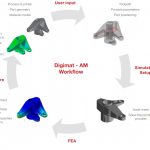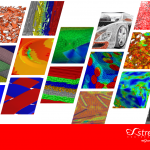Digimat: Nonlinear Multi-scale Material and Structure Modeling Platform
Digimat technology provides design tools that give the user 100% confidence in their composites products thanks to an accurate description of the local composite behavior. Accurate material modeling allows one to reduce the "factor of safety" - allowing composite materials to used to 100% of their potential, maximizing their competitiveness against metal and leading to substantial weight reduction. Digimat tools integrate smoothly within the current FEA process, bridging the gap between manufacturing process and structural analysis.
Digimat technology connects the whole value chain together (Material Suppliers, Tier1 and OEMs) and helps to:
- Investigate and predict the behavior of a large mix of composite materials
- Design & Manufacture Innovative High-Performance Composite Parts
- Minimize weight, cost and time-to-market optimal composite industrial parts
- Improve prediction of structural FEA by accounting for manufacturing process
- Reduce material testing and prototyping
More than just software, Digimat brings and organizes together the complete composite market, bridging the gap between manufacturing and performance. Digimat lets engineers do both micro- and macro-scale analyses of composites, predicting how they will perform and calculating their mechanical, thermal and electrical properties for use in all sorts of downstream FEA analyses.
Digimat-MF
Digimat-MF is the mean field homogenization tool to rapidly compute the macroscopic performance of composite materials from their per-phase properties and microstructure definition. Digimat-MF aims at the realistic prediction of the non-linear constitutive behavior of multi-phase materials taking into account temperature and strain rate dependencies. The composite morphology such as filler content, length, aspect ratio and orientation take full impact on the resulting composite behavior. Digimat-MF is accurate, efficient and very easy to learn and use. Digimat-MF is used mainly by universities, research institutes and material suppliers, as well as OEMs and Tier1s research departments.
Digimat Mean Field homogenization technology is especially well suited to describe fiber reinforced composites:
- Short fiber reinforced plastics
- Long fiber thermoplastics
- Unidirectional composites
- Woven composites
- Sheet Molding Compound
A broad range of performances can be predicted realistically with Digimat Mean Field homogenization technology :
Digimat-FE
Digimat-FE generates realistic (stochastic) Representative Volume Elements (RVEs) for a large variety of material microstructures and can as well rely on external geometric microstructure description such as micro CT-scan or molecular dynamic results.
Based on material input and the microstructure definition, a finite element model is built and run. Various solvers are accessible to perform simulations including an embedded FEA solver, a Fast Fourier Transform solver and external solvers. The results of the FE analysis is post-processed in the sense of probabilistic distribution functions that give detailed insight into the RVE. Mean homogenized values are computed and can be used in subsequent FE analysis on the structural part level.
A complete end-to-end solution has been implemented in Digimat®. It allows performing all the different steps needed to obtain a complete FE analysis – starting from the material data. For example for woven composites those steps are:
- Extraction of the material data from the datasheet
- Mean-field homogenization of the yarns
- Generation of a geometry of a unit cell
- Generation of a RVE
- Voxelisation
- FE model definition and application of periodic boundary conditions
- Solving the FE analysis
- Post-processing the outputs of the FE analysis
Digimat-RP
Digimat-RP: The Leading Solution for Reinforced Plastic Parts Simulation!
Digimat-RP is a Solution of Digimat software that integrates the right Digimat Tools and features to design Reinforced Plastics
Lightweight engineering re-designs metal parts into fiber reinforced plastics produced by injection molding. For reinforced plastics manufacturing procedures influence the material microstructure. The effect of local fiber orientation leads to a distribution of material properties over the part. This can drastically influence its final performance and must be taken into account in the design procedures. Digimat-RP (“Reinforced Plastics”) provides engineers with a guided simulation workflow tool that aids in the setup and streamlines the process of accurate analysis of plastic parts in a robust, fast and easy manner. It bridges the gap between injection molding and nonlinear FEA of plastic parts.
Digimat-RP simulation solution for Reinforced Plastics allows in a user friendly way to
- Load finite element analyses of a broad range of different solvers
- Assign a micromechanical material model to a specific part
- Choose a robust & fast multi-scale simulation method for a coupled analysis
- Map local microstructure information onto the part
- Launch & monitor the coupled analysis
- Access the results of the multi-scale simulation
Digimat-HC
Digimat-HC for Honeycomb composite sandwich panels simulation
Digimat-HC is a Solution of Digimat software that integrates the right Digimat Tools and features for the virtual design of honeycomb composite sandwich panels.
The performance of composite sandwich panels depends on the properties of the skin and the core. These are determined by the choice of the underlying microstructure. The core is sensitive to the structure of the constituting honeycomb. The composite skins feel the selected type of fibers and stacking of layers with different orientations. Design choices are typically investigated in bending and shear tests.
The virtual design of a composite sandwich panel requires an efficient multi-scale modeling strategy:
The virtual design of a composite sandwich panel requires a multi-scale modeling strategy to be able to map the effect of the microstructure onto the macroscopic performance of the panel. In a coupled analysis the full setup of the panel can be varied and the impact on the final performance under bending and shear investigated in an easy & efficient way.
Digimat-HC simulation solution for Honeycomb composites sandwich panels allows in a user friendly way to:
- Set up the structure of a composite sandwich panel
- Define the properties of the core (honeycomb & foam)
- Define the properties of the skins (UD, woven & chopped fibers)
- Investigate the panel design under different scenarios (3-/4-point-bending & shear)
- Flexibly access the results of the analysis (field plot & through-thickness path analysis)
Digimat-AM
Digimat-AM is a solution of Digimat Software that simulates the printing process and helps printer manufacturers and end-users to identify manufacturing issues. It also optimizes printing parameters for productivity and final part performance prior to printing the first part. The use of numerical simulation allows you to turn hundreds of trials and errors into a couple of clicks in Digimat-AM.
Digimat -AM empowers engineers with a process simulation solution that helps:
- Simulate the FFF, FDM, SLS and CFF processes of unfilled and reinforced materials
- Predict the as-printed part warpage, residual stresses and process-induced microstructure
- Analyze the coupled thermal-structural response of the process for unfilled and reinforced polymers
- Set up the right manufacturing parameters for high precision printing and further bridge the gap between printing process, material and part performances.
Built upon our partnerships among the AM ecosystem, the software workflow follows the real printing process intuitively, allowing non FEA experts to fully benefit from our software solution.
Digimat-AM simulation solution for Additive Manufacturing allows in a user friendly way to:
- Choose additive manufacturing process
- Select the printer from a dedicated database with predefined parameters, or specify user-defined parameters
- Load the part geometry in STL format
- Load the slicing or toolpath definition
- Select the material grade (reinforced or unfilled polymer) and the associated material model from Digimat-MX database
- Create the voxel mesh of the part
- Solve the thermo-mechanical or thermal finite element analysis simulating the printing process
- Post-process and export the results of the process simulation (stress/strain fields, warped part shape, …)
- Optimize the process
Supported AM Processes:
- Selective Laser Sintering (SLS)
- Fused Filament Fabrication (FFF)
- Fused Deposition Modeling (FDM)
- Continuous Fiber Fabrication (CFF)
WE WORK WITH YOU
We pride ourselves on empowering each client to overcome the challenges of their most demanding projects.
Enteknograte offers a Virtual Engineering approach with FEA tools such as MSC Softwrae(Simufact, Digimat, Nastran, MSC APEX, Actran Acoustic solver), ABAQUS, Ansys, and LS-Dyna, encompassing the accurate prediction of in-service loads, the performance evaluation, and the integrity assessment including the influence of manufacturing the components.

Finite element simulation of woven fabric composites
Finite Element Simulation of Braided Composites
Unidirectional composites (UD) Simulation-Based Design
Discontinuous Fiber Composites: Finite Element Simulation
Hard Metal: Finite Element Simulation for Mechanical Properties on the Microstructural Level
FEA Based Simulation of Rubber Matrix Composite: Tires, anti-vibration systems, seals or hoses
Plastic materials: Thermoplastics (PA, PP, PC, POM, PPA) and Thermosets (Epoxy, Polyurethane) reinforced with short, long or continuous glass and/or carbon fibers
Composites Fatigue Finite Element Simulation
Finite Element Simulation of Crash Test and Crashworthiness with LS-Dyna, Abaqus and PAM-CRASH
Seat Design: Finite Element and CFD Simulation for Static & Dynamic Comfort, Whiplash, Acoustic & Thermal Comfort, Crash Test
Acoustics and Vibration: FEA and CFD for AeroAcoustics, VibroAcoustics and NVH Analysis
FEA Based Composite Material Design and Optimization: MSC Marc, Abaqus, Ansys, Digimat and LS-DYNA
Heat Transfer and Thermal Analysis: Fluid-Structure Interaction with Coupled CFD and Finite Element Based Simulation
Integrated Artificial Intelligence (AI) & Machine Learning - Deep Learning with CFD & FEA Simulation
Vibration Fatigue Finite Element Simulation: Time & Frequency Domain
eVTOL (Electric Vertical Take-Off and Landing) & UAM (Urban Air Mobility)
Finite Element Analysis of Durability and Fatigue Life
Additive Manufacturing and 3D Printing






















